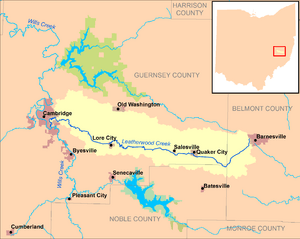Leatherwood Creek (Wills Creek tributary) facts for kids
Quick facts for kids Leatherwood Creek |
|
|---|---|

Leatherwood Creek in Cambridge in December 2010
|
|

Leatherwood Creek and its watershed
|
|
| Country | United States |
| State | Ohio |
| Counties | Belmont, Noble, Guernsey |
| Municipalities | Quaker City, Salesville, Lore City, Cambridge |
| Physical characteristics | |
| Main source | near Barnesville in Warren Township, Belmont County 1,139 ft (347 m) 39°59′25″N 81°11′21″W / 39.9903483°N 81.1892745°W |
| River mouth | Wills Creek Cambridge 778 ft (237 m) 40°00′36″N 81°34′36″W / 40.0100720°N 81.5767893°W |
| Length | 28.6 mi (46.0 km) |
| Basin features | |
| Basin size | 91.6 sq mi (237 km2) |
Leatherwood Creek is a stream in eastern Ohio, United States. It is about 28.6 miles (46 kilometers) long. This creek flows into Wills Creek. From there, its water joins the Muskingum and Ohio rivers. Eventually, its water becomes part of the huge Mississippi River system.
Leatherwood Creek helps drain an area of about 91.6 square miles (237 square kilometers). This area is part of the Allegheny Plateau, a hilly region that was not covered by glaciers long ago.
Where Leatherwood Creek Flows
Leatherwood Creek begins near the town of Barnesville in Belmont County. It then flows mostly west. The creek passes through a small part of Noble County.
Most of its journey is through Guernsey County. Here, it flows through several townships. These include Millwood, Richland, Wills, Center, and Cambridge townships. The creek also goes through the towns of Quaker City, Salesville, and Lore City. Finally, Leatherwood Creek flows into Wills Creek in the southern part of Cambridge.
How Leatherwood Creek Got Its Name
The creek was named after a plant called leatherwood. This plant used to grow a lot along the creek's banks.
Water Flow and Speed
Scientists measure how much water flows in the creek. This is called the flow rate. The United States Geological Survey (USGS) has a special station near Kipling.
Between 2000 and 2011, the average flow of the creek was about 82.9 cubic feet per second (2 cubic meters per second). To give you an idea, that's like filling two large bathtubs with water every second!
The highest flow ever recorded during that time was on September 18, 2004. The creek was flowing at 10,100 cubic feet per second (286 cubic meters per second). That's a lot of water moving very fast! On the other hand, on September 2, 2003, the creek had no flow at all. This means it was completely dry in that spot.

